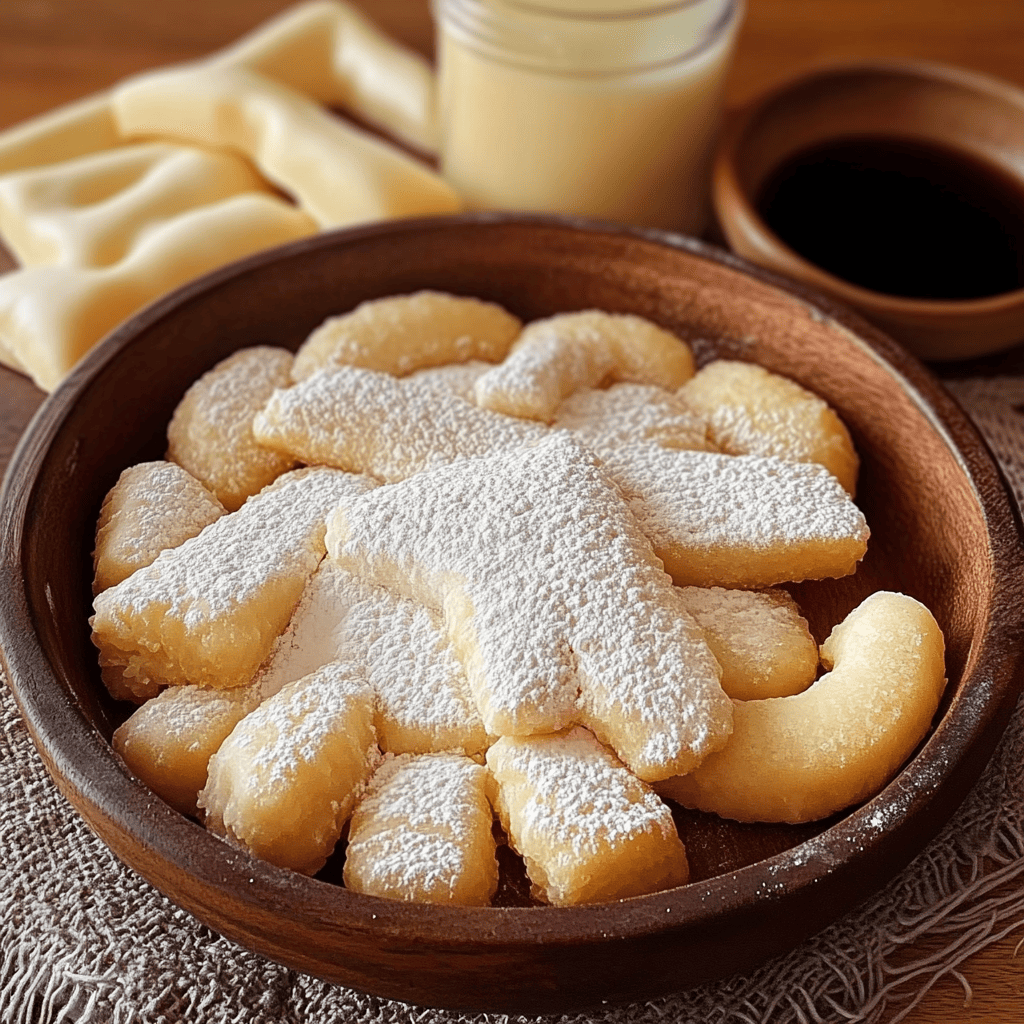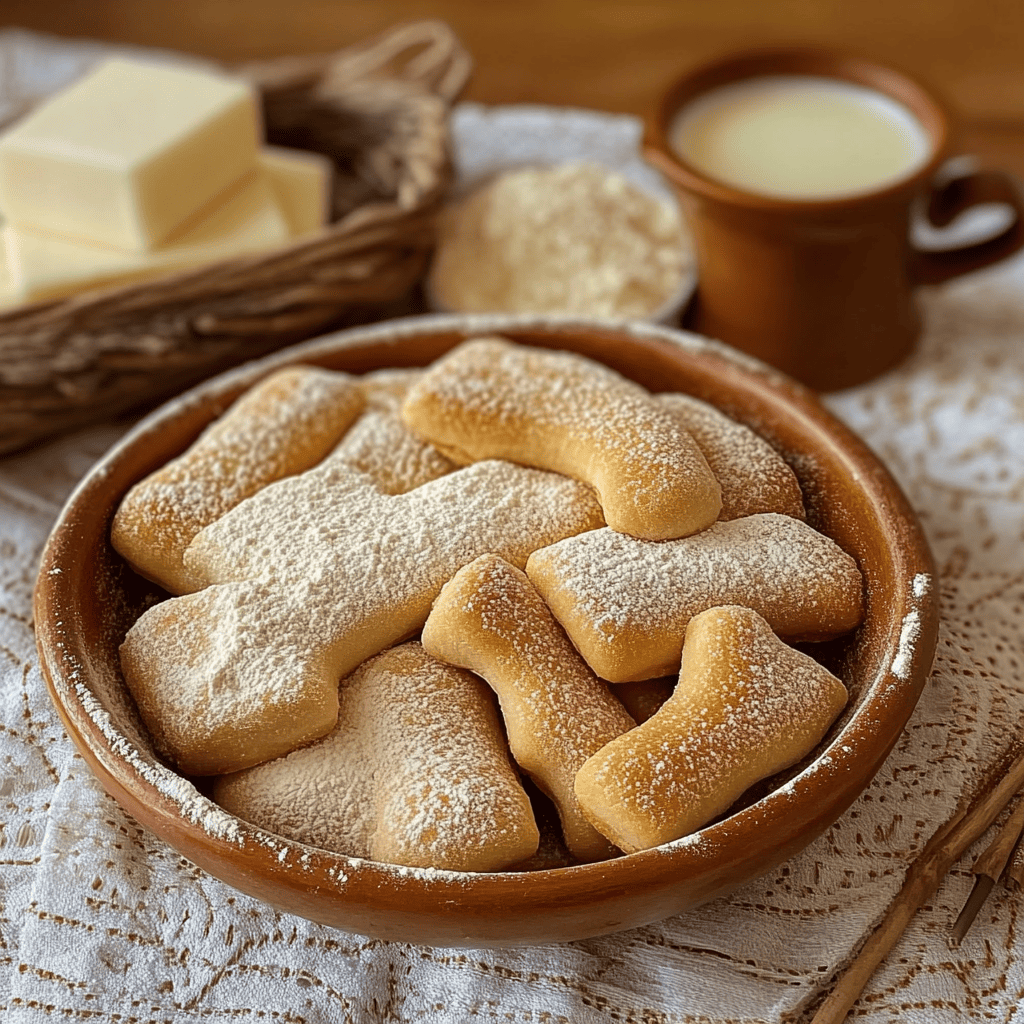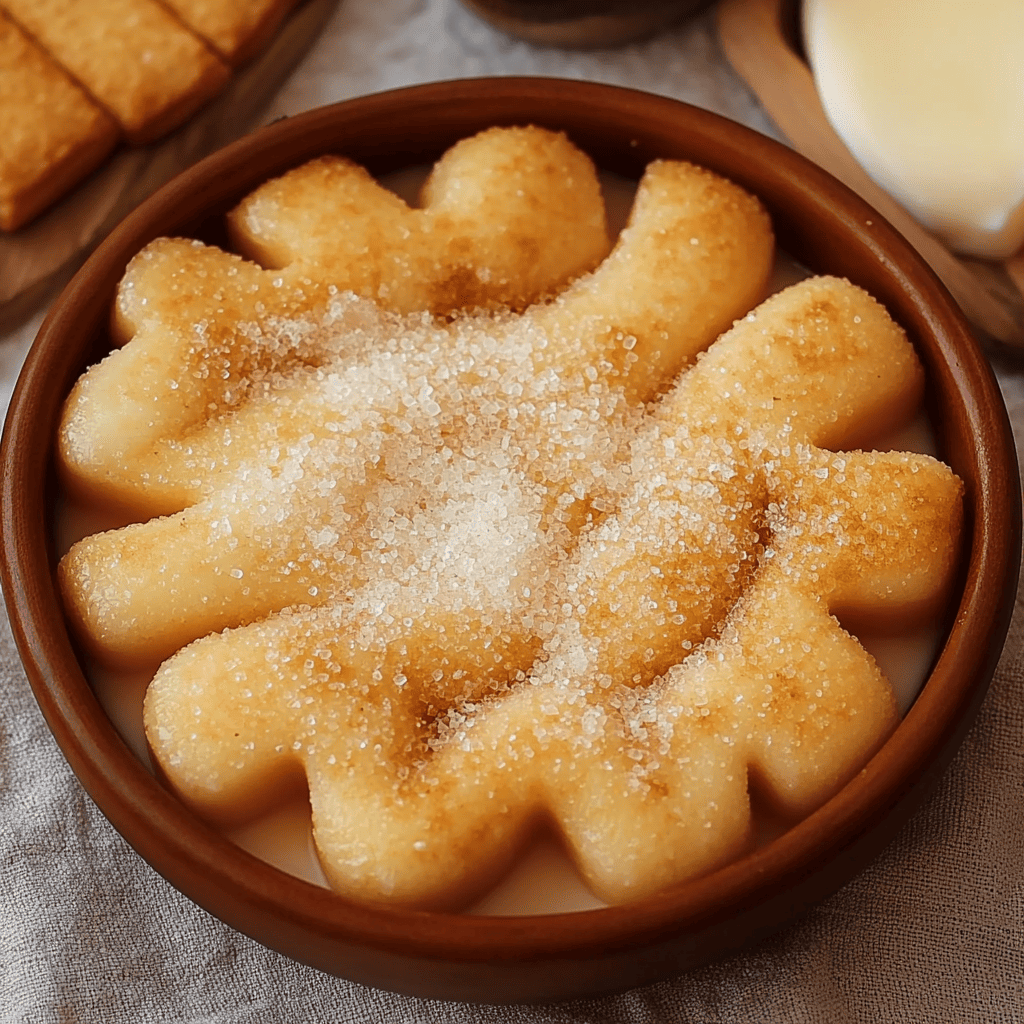Overturned Underwear (Grostoli / Coscorões): A Crunchy and Traditional Sweet
Introduction: A Festive Home Baking Classic
“Ropa Interior Volcada,” known by names like Grostoli or Coscorões in various cultures, is a fried sweet that stands out for its simplicity and delicious flavor. It consists of a thin, elastic dough that is stretched, cut into strips, and knotted or shaped into a distinctive shape before being fried until it achieves a crispy, golden texture. Finally, it is sprinkled with a mixture of sugar and cinnamon, creating a perfect balance of sweetness and spice. This dessert is a classic for holidays, celebrations, and special occasions, evoking memories of homemade and family baking. Discover all the secrets of this delicious and traditional delicacy!
Detailed History in Spanish: A Legacy of Fried Sweets with Ancient Roots
The history of fried dough sweets is as old as baking itself. Many cultures around the world have their own versions of fried dough, prepared for celebrations or as everyday desserts.
Origin and Various Names: This type of sweet has deep roots in European cuisine, especially in the Mediterranean and Eastern European regions. Names like Grostoli are common in Italy (particularly in the north, where they are known as chiacchiere , frappe , galani or bugie ), Croatia and Slovenia, reflecting the influence of Venetian or Austro-Hungarian cuisine. In Portugal and Brazil, they are known as Coscorões , and are a typical Carnival or Christmas dessert. The name “Ropa Interior Volcada” is a picturesque literal translation that alludes to their twisted or knotted shape after being fried.
The Tradition of Carnival and Lent: In many of these cultures, these sweets are traditionally associated with the Carnival period, before Lent. They were a way to use up rich ingredients like eggs and fat before fasting, and to celebrate with festive meals. The simplicity of their ingredients (flour, eggs, sugar) and their ease of producing large quantities made them ideal for these celebrations.
The Use of Alcohol (Vinegar or Cachaça): The addition of a splash of vinegar or an alcoholic beverage such as cachaça (in Brazil) or aguardiente (in other regions) is an interesting feature of these recipes. It is believed that the acid or alcohol helps make the dough more elastic and the fried dessert more “sequinha” (dry inside, less greasy) and crispy, as it reduces the absorption of oil during frying. The alcohol evaporates during cooking, leaving only its effects on the texture.
“Ropa Interior Volcada” is a perfect example of how a seemingly simple sweet can have a rich history and deep cultural significance, adapting and evolving across different regions and eras. Its enduring popularity lies in its delicious texture and the comfort it offers as a homemade treat.
More Historical Detail: Regional Influences and Evolution of the Recipe
Digging a little deeper into the history of Ropa Interior Volcada (Grostoli / Coscorões), we can consider some influences:
- Roman Influence: Many of these European fried sweets are believed to have roots in ancient Roman cuisine, where similar preparations based on fried dough and honey were eaten at festivals. The Roman “frictilia” may be a precursor.
- The Diaspora and Globalization: As European immigrants settled in new lands (especially in Latin America), they brought their traditional recipes with them, adapting them to local ingredients and customs. This is why we find versions of these sweets in countries like Brazil, Argentina, and Uruguay.
- Monastic Pastries: In the Middle Ages and Renaissance, monasteries played a crucial role in the evolution of pastries, perfecting techniques and creating many of the recipes we know today. These fried doughs may also have originated or been refined in these contexts.
- Sugar and Cinnamon: The custom of sprinkling sugar and cinnamon on fried sweets is a common tradition in many cultures, enhancing the flavor and adding visual appeal. Cinnamon, an exotic spice, became popular in Europe along trade routes.
The differences in names and slight variations in ingredients (for example, the use of lemon peel, orange zest, or specific liqueurs) demonstrate the rich culinary diversity within this fried sweet tradition. The key to its appeal has always been the light, airy texture achieved by frying the thinly stretched dough.

Ingredients & Detailed Preparation
Ingredients:
- Wheat flour: 3 cups (tea)
- Sugar: 6 tablespoons
- Milk: ½ cup (tea)
- Salt: 1 pinch
- Egg: 1 unit
- Margarine: 1 tablespoon (or butter at room temperature)
- Vinegar or cachaça: 1 tablespoon (soup)
- Baking powder (Royal type): 1 tablespoon (dessert)
- Sugar and cinnamon (mixed for sprinkling): As needed
- Oil: Amount needed for frying
Detailed Preparation:
- Prepare the dough: In a large bowl, combine the wheat flour, 6 tablespoons of sugar, a pinch of salt, and the baking powder. Mix the dry ingredients well.
- Make a well in the center of the flour mixture. Add the egg, milk, margarine (or softened butter), and vinegar or cachaça.
- Kneading: Knead all the ingredients until you have a smooth, elastic, and even dough. You can knead it by hand on a lightly floured surface or use a mixer fitted with a dough hook. The dough should be easy to handle and not sticky. If it’s too sticky, add a little more flour; if it’s too dry, add a splash of milk.
- Rest the dough: Cover the dough with a clean cloth or plastic wrap and let it rest at room temperature for at least 30 minutes. This helps the gluten relax and makes the dough easier to roll.
- Roll out the dough: On a lightly floured surface or using a pasta machine (if you have one), roll out the dough as thin as possible. The key to crispy crusts is to have a very thin, almost transparent dough.
- Cutting and Shaping: Using a knife or pizza cutter, cut the rolled-out dough into rectangles or strips approximately 3-4 cm wide by 8-10 cm long.
- To give them the traditional “upside-down underwear” shape, make a longitudinal cut in the center of each rectangle, not reaching the ends. Then, pass one end of the rectangle through the cut, twisting it around itself to create a “knot” or twisted bow. (See the image for reference for the final shape.)
- Prepare the oil for frying: In a deep skillet or pot, heat plenty of vegetable oil over medium-high heat (approximately 170-180°C / 340-350°F). The oil should be hot enough to brown the sweets quickly without absorbing too much oil. You can test the temperature with a small piece of batter; if it bubbles and rises quickly, it’s ready.
- Fry the sweets: Fry the sweets in batches, without overcrowding the pan, so they brown evenly. Cook for 1-2 minutes on each side, or until golden brown and crispy.
- Drain: Using a slotted spoon, remove the fried sweets from the oil and place them on absorbent paper to remove excess fat.
- Sprinkle: While the sweets are still warm, sprinkle them generously with the sugar and cinnamon mixture.
- Serving: Serve the Grostoli/Coscorões warm or at room temperature and enjoy their delicious flavor and texture.
Estimated Preparation Time
- Dough preparation: 15-20 minutes
- Dough rest: 30 minutes
- Stretch, cut and shape: 20-30 minutes
- Frying: 15-25 minutes (depending on the size of the pan and the number of batches)
- Total time: Approximately 1 hour 20 minutes – 1 hour 45 minutes
Additional Tips
- Thin dough: The key to crispy Grostoli is to roll the dough as thin as possible. If you have a pasta machine, it’s ideal for achieving this.
- Oil Temperature: Keep the oil at a constant temperature so they don’t burn on the outside and remain raw on the inside, or absorb too much oil. If the oil is too cold, they’ll soak up the fat; if it’s too hot, they’ll burn quickly.
- Don’t overcrowd the pan: Fry in small batches to ensure the oil doesn’t drop too much and the sweets cook evenly.
- Freshness: These sweets are best the day they are made, when they are crispiest.
- Flavor variations: You can add lemon or orange zest to the dough for a citrusy touch. You can also experiment with other spices like nutmeg.
- Decoration: In addition to sugar and cinnamon, you can sprinkle a little pure icing sugar for a more delicate look.

Frequently Asked Questions
- Can I bake them instead of frying them? Although frying is traditional for achieving the characteristic texture, you could try baking them for a lighter version. However, the texture won’t be the same; they’ll probably be more like crispy cookies. If you bake them, try baking them at 180°C (350°F) for about 10-15 minutes, until golden brown.
- Is cachaça/vinegar essential? It helps achieve a crispier, less greasy texture, but if you don’t have any, you can omit it. The texture may be slightly different.
- How long do they last? Stored in an airtight container at room temperature, they can last for 3-5 days, although they are at their freshest and most crunchy on the first day.
Texture and Flavor
The texture of Ropa Interior Volcada is distinctively crisp and light on the outside, with a slightly airy crumb on the inside. Because they’re so thin, they melt easily in the mouth, leaving a light sensation. The sprinkle of sugar and cinnamon adds a slightly grainy texture.
The flavor is sweet and aromatic, with the sweetness of sugar and the warm, spicy note of cinnamon. The dough itself has a neutral flavor that allows the cinnamon and sugar to shine. A slight citrus note if zest is added, or a subtle aroma of liqueur if used, complements the sweetness. It’s a comforting, classic flavor that evokes home.
Consumer Context
These sweets are perfect for various occasions:
- Festivities: Especially popular during Carnival, Christmas or Easter in many cultures.
- Snack: A delicious accompaniment to coffee, tea or hot chocolate.
- Family celebrations: Easy to prepare in large quantities to share.
- Homemade dessert: A sweet and comforting treat for any moment.
- Picnics and informal gatherings: They are easily transported and consumed.
Visual Aspect
Overturned Underwear has a deep, uniform golden color, with slightly contrasting sugar and cinnamon sprinkles on the surfaces. Their distinctive, twisted or looped shape makes them visually interesting and recognizable. They are presented stacked on a plate, creating a mountain of mouthwatering sweets.
Curiosities
- Evocative names: The names of these sweets often reflect their shape or origin. “Chiacchiere” in Italian means “gossip” or “chatter,” perhaps because of their lightness and how easy they are to eat while chatting.
- Deep-Frying Tradition: Deep-frying sweets in batter is an ancient culinary technique found in almost every culture, from Spanish buñuelos to American doughnuts to Indian jalebi .
- Baking powder vs. baker’s yeast: Baking powder is used in these types of pastries for a faster rise and airy texture, unlike baker’s yeast, which produces a slower rise and a different texture.
Nutritional Value (Estimated per Serving – 1 medium piece)
Please note that these values are approximate and may vary significantly depending on the serving size, the amount of oil absorbed during frying, and the amount of sugar and cinnamon sprinkled on the cake. These are calorie-dense sweets.
- Calories: 80-120 kcal
- Protein: 1-2 g
- Fat: 5-8 g (most of the fat from frying)
- Saturated fat: 1-2 g
- Carbohydrates: 8-12 g (mainly from flour and sugar)
- Sugars: 3-6 g
- Fiber: Less than 1 g
Additional Benefits and Interesting Facts
- Nostalgic taste: For many, these sweets evoke memories of childhood and family celebrations.
- Easy to scale: The recipe can be easily doubled or tripled to prepare large batches for events.
- Presentation versatility: They can be served on a large plate to share or in individual bags as gifts.
Other Information
- Storage: Store candy in an airtight container at room temperature to maintain its crunch. Avoid refrigeration, as it may cause it to lose its texture.
- Serving: Best enjoyed warm or at room temperature, accompanied by a hot beverage.

Conclusion: A Sweet and Crunchy Journey into Tradition
Overturned Underwear, Grostoli, or Coscorões, is more than just a fried sweet; it’s a piece of culinary history and a celebration of homemade baking. Its preparation is an act of love that results in a crunchy, sweet, and aromatic delicacy, perfect for sharing and creating new memories. The simplicity of its ingredients contrasts with the richness of its texture and flavor, making it a perennial favorite on many tables. Go ahead and make them and enjoy this traditional bite in every crunchy bite!

